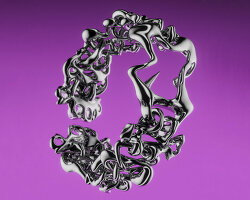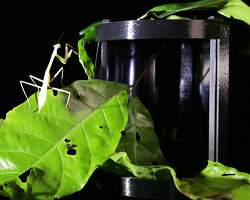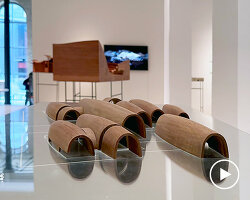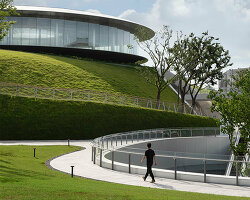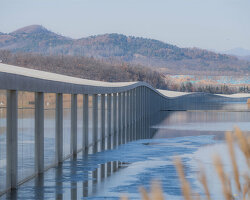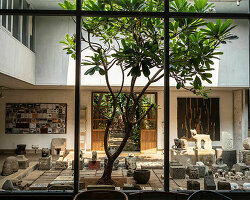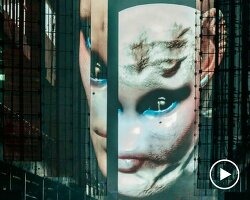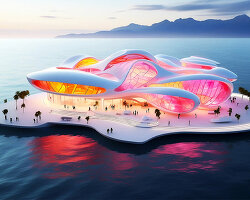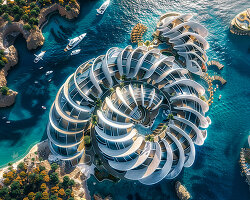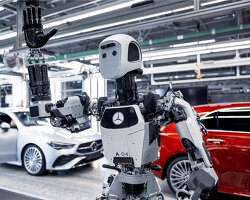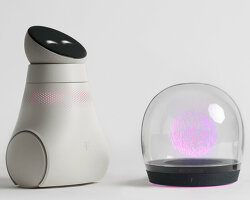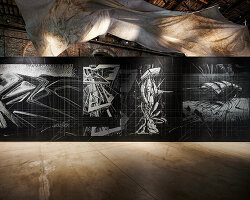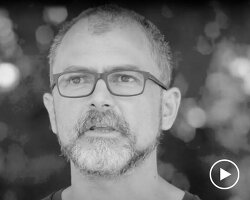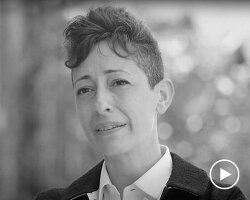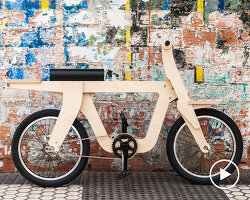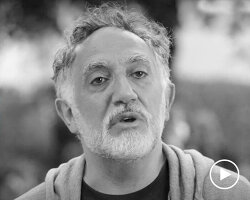presented at the 2021 venice architecture biennale, ‘magic queen’ is a 3D printed landscape cared for by a robotic ‘gardener’. comprising 90 tonnes of local soil, the biodegradable structure was printed directly in the arsenale over a three month period and will house different species of plants and mushrooms of the course of the event. the project has been conceived by MAEID — an interdisciplinary practice based led by daniela mitterberger and tiziano derme — as a built habitat that can restore and nurture itself, redefining the role of living systems within architecture.
‘the idea behind ‘magic queen’ is to have a structure that is able to evolve, decay, and grow during the timespan of the biennale,’ daniela mitterberger and tiziano derme tell designboom. ‘the structure was seeded with different types of grasses and inoculated with mushroom spores during and post-fabrication.’
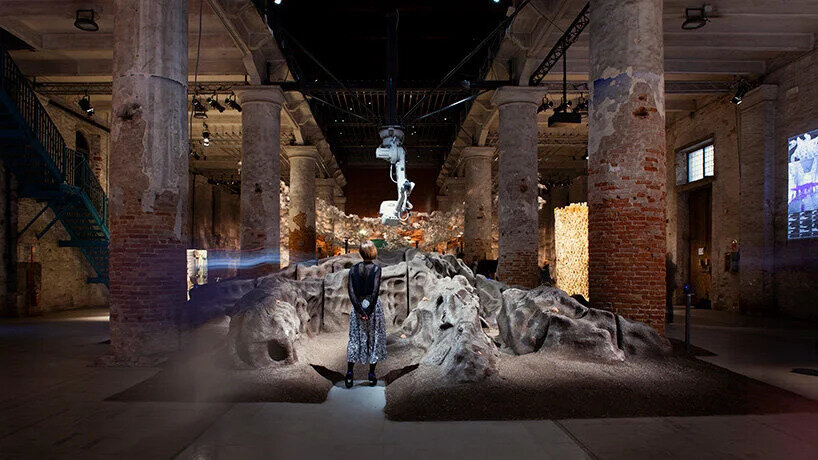
image © zita oberwalder | video © MAEID / sassy films ltd
MAEID explains that ‘magic queen’ represents a hybrid environment that incorporates and fuses biological systems with organic materials and machines — creating an ecosystem of empathy and co-existence. ‘the project’s space presented on the occasion of the biennale of architecture is a performative soil-3D printed robotic garden that uses sensors, responsive technologies, and machine learning to create continuous feedback between sensing, virtualizing, and induced change,’ mitterberger and derme continue. the project explores the deeper meaning of the relationship between nature, technology, and living systems favoring the creation of an ecology of non-human subjects.
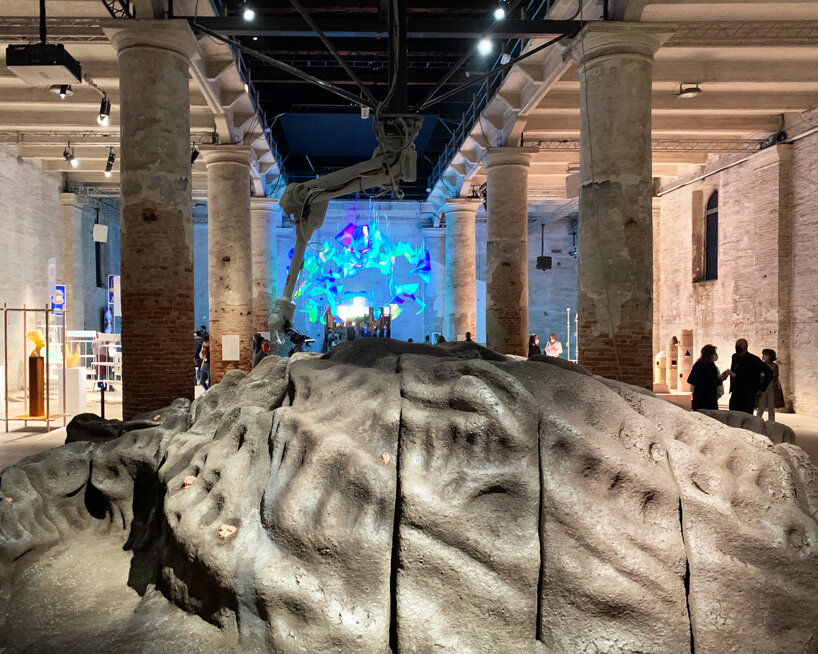
image © designboom
the team behind the project explains that the inhabitable space combines visual, auditory, olfactory, and haptic features to capture the sensual experience of this new mediated form of nature, which evolves around and within different media and forms of representation. ‘nothing in ‘magic queen’ could exist without the presence of the other, underlining the nature of interconnectivity in biological entities,’ says daniela mitterberger and tiziano derme. ‘the fungal flora and the soil structure depend on the robot to water them. at the same time, the robot relies on its existence to move.’
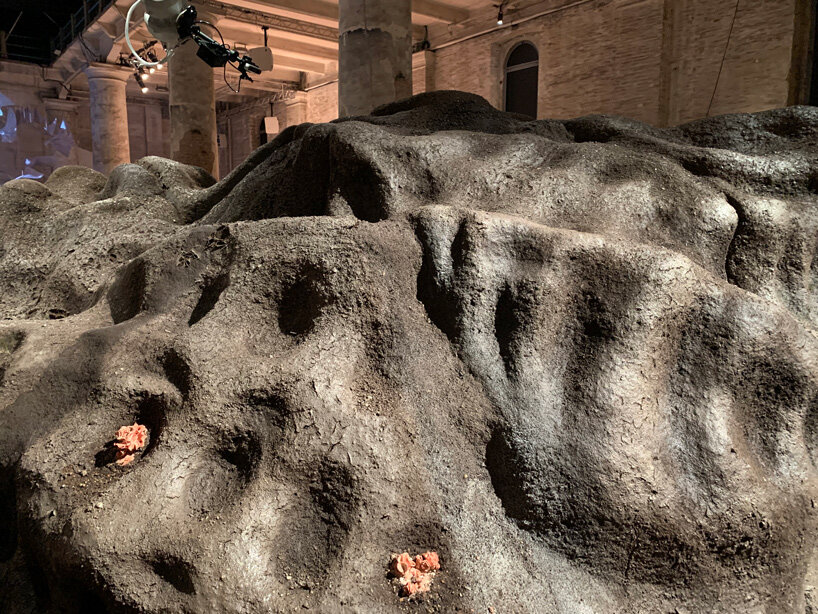
image © designboom
suspended from above, the ABB robot scans the ‘techno-organic’ topography below. this robotic gardener is equipped with two types of tools and sensors: first, a watering system to garden the seeds of the mushrooms in the soil, and second, a machine vision system to detect and register any changes in the surface texture and growth of biological entities on the structure. the architects say that the ambient sound is a mixture of artificially produced sounds and natural tones, which is continuously influenced and manipulated by the movements of the hanging robot and the changes in the structure.
find out more about the project in our in-depth interview with daniela mitterberger and tiziano derme below.
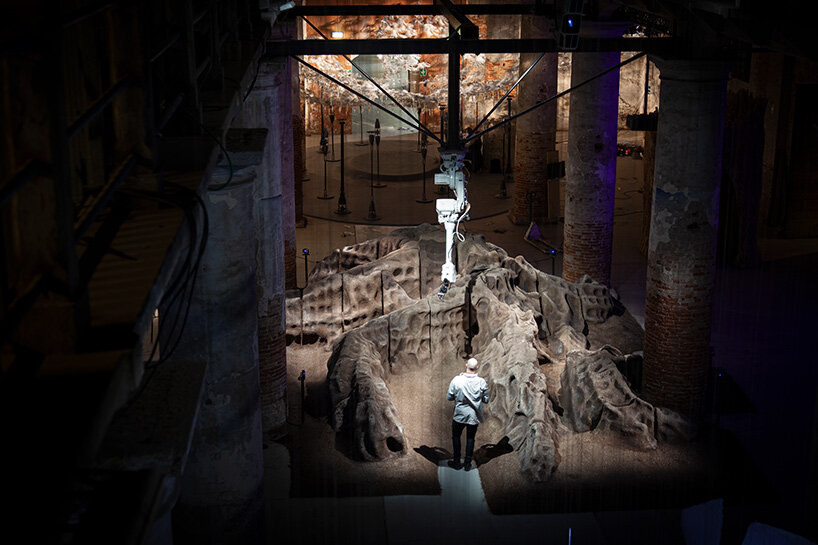
image © zita oberwalder
designboom (DB): can you briefly introduce ‘magic queen’ and the issues it seeks to address?
daniela mitterberger (DM) and tiziano derme (TD): magic queen is a performative, living architecture: a 3D-printed earth landscape maintained by a robot arm. the structure was erected on site by man and machine within three months. only soil from the region and bio-materials were used — the installation is therefore completely biodegradable. various plants and fungi grow on the installation throughout the exhibition; a robotic arm carries out the gardener’s function.
the project reflects on the often troubled, incompatible, and even oppressive binary relationship between the built environment and the natural environment as defined by western modernity while proposing an alternative to the current cultural associations to nature as ‘green’ or ‘sustainable’ (karafyllis, 2002). the project offers an alternative material driven-design approach where robotic fabrication processes are coupled with natural systems and environmental agents (mitterberger and derme, 2020).
video © MAEID / sassy films ltd
DM + TD (continued): magic queen represents a garden incorporating and fusing biological systems with organic materials and machines, creating an ecosystem that depends on all elements in the system. the project explores the deeper meaning of the relationship between nature, technology, and living systems favoring the creation of an ecology of non-human subjects. these non-human subjects are in magic queen the biomaterial, the robot, the grass, and the mushrooms. in this scenario, magic queen is conceived as a built habitat that can restore and nurture itself, redefining the role of living systems within architecture. magic queen is the third installment of the series artificial ecologies after pahoehoe beauty (ars electronica, 2018) and terrestrial reef (royal chelsea flower show,2019) developed in collaboration with the university of innsbruck and the chair of marjan colletti.
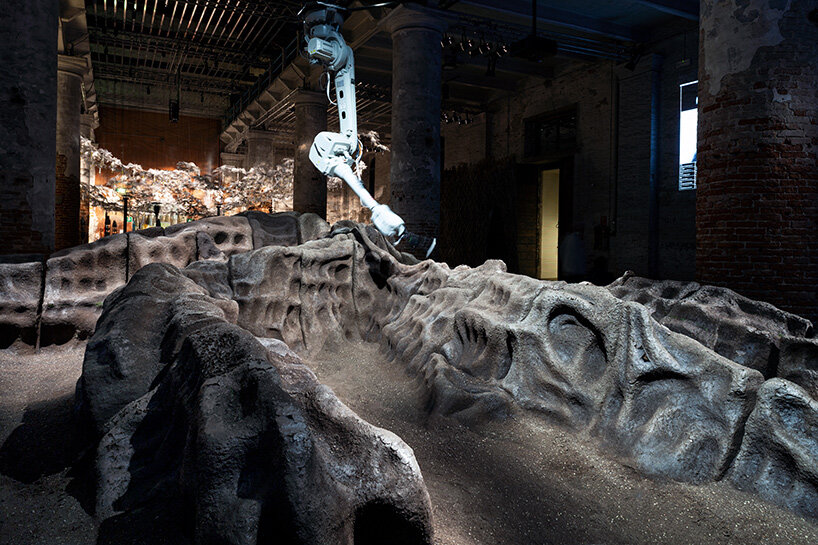
image © zita oberwalder
DM + TD (continued): the project’s space presented on the occasion of the biennale of architecture is a performative soil-3D printed robotic garden that uses sensors, responsive technologies, and machine learning to create continuous feedback between sensing, virtualizing, and induced change. the inhabitable indoor environment of magic queen combines visual, auditory, olfactory, and haptic features to capture the sensual experience of this new mediated form of nature, which evolves around and within different media and forms of representation. nothing in magic queen could exist without the presence of the other, underlining the nature of interconnectivity in biological entities. the fungal flora and the soil structure depend on the robot to water them. at the same time, the robot relies on its existence to move. the ambient sound is generated through the interconnectivity and performativity of all elements, accompanied by a visual interface uncovering the otherwise invisible stream of impact and growth.
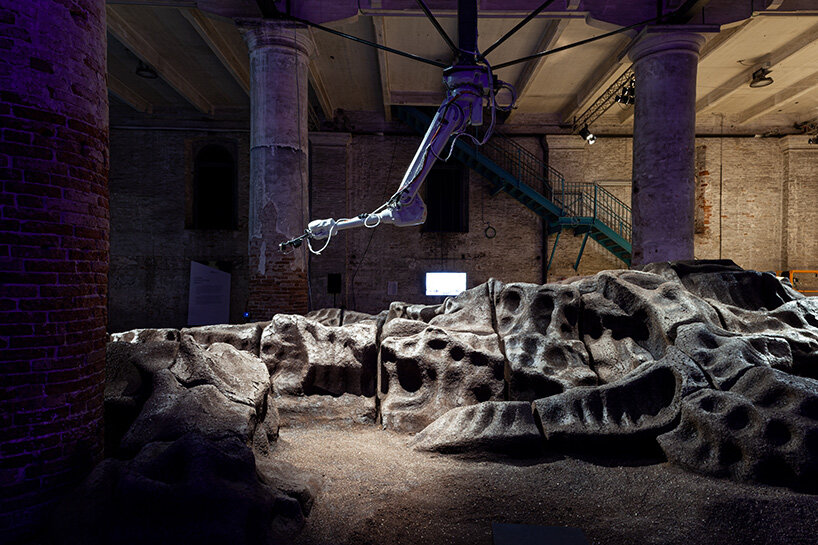
image © zita oberwalder
DB: why should we encourage self-sufficient environments?
DM + TD: human societies have shaped and influenced ecological patterns and the biosphere significantly, either directly through agriculture, initiating species migration, pollution, and climate change. to sustain ecological patterns without altering them any further also became increasingly more difficult and complex. this process fostered the idea to promote the autonomy of environmental processes and non-human species by using novel technologies to free ecological systems from human interventions. with the advent of new autonomous, deep learning technologies and robots, we begin to envision such new wild environments that have the potential to operate independently — a new ‘wilderness’.
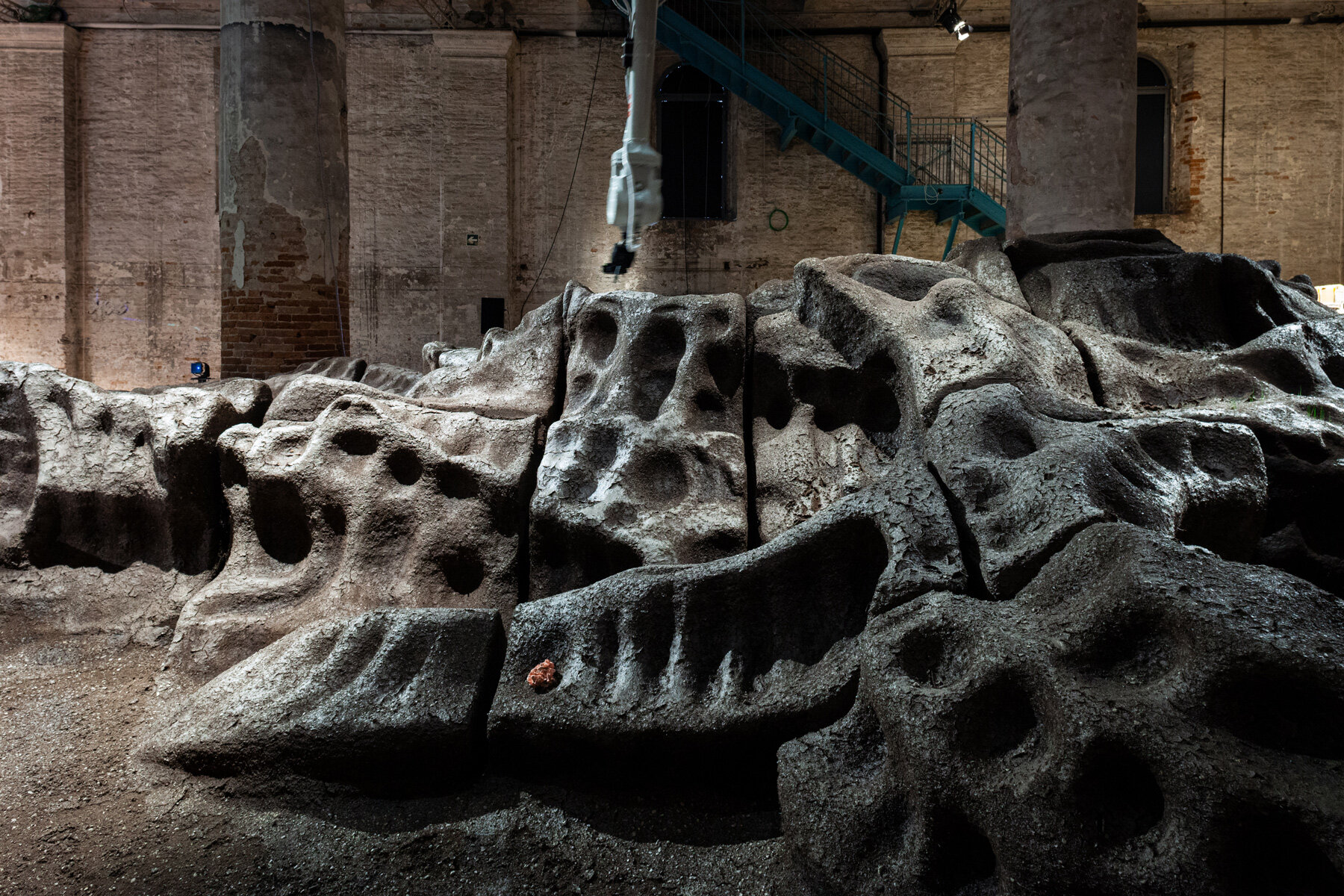
image © zita oberwalder
DM + TD (continued): for these systems to be self-supporting, building materials and binders must promote such life forms and therefore be completely biodegradable and organic — soil is such a material that can foster life. magic queen displays a futuristic nature where plants and soil are interconnected with robotics, AI, responsive technologies, sense, and monitoring. this condition challenges our response and interaction with the built and natural environment. it represents an opportunity to radically redesign and re-naturalize the decision-making process of design manufacturing and digital fabrication to create structures ‘designed from a distance’ and allow ecological systems to co-evolve through their interactions.
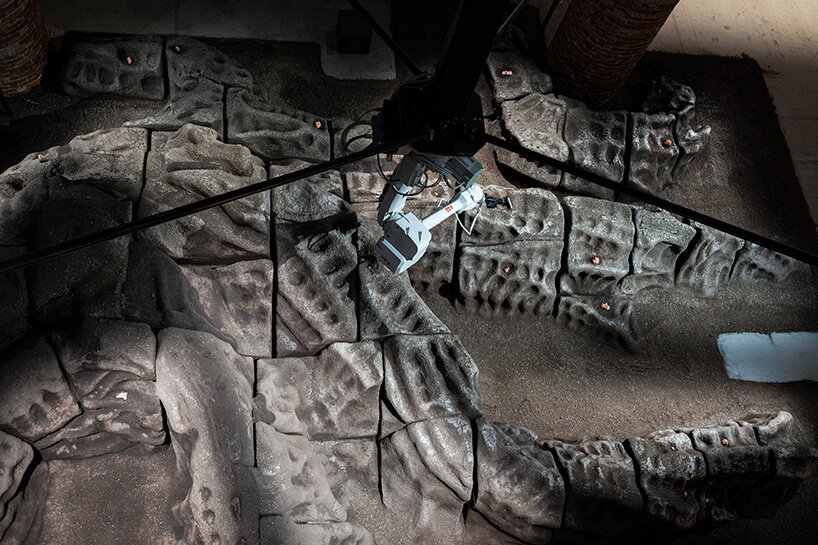
image © zita oberwalder
DB: what is the role of the robotic ‘gardener’? what are its duties?
DM + TD: the robotic arm hovering over the structure will be watering the mushrooms and plants. it will monitor the soil ecosystem over six months, gathering physicochemical data and translating this data into audible sounds and a visual interface. the robotic arm is understood as what we usually would associate with ‘gardener.’
robotic and autonomous technologies enable us to imagine new environments that can operate autonomously of human decisions and interventions. those environments possess the technological capacity to fabricate, sense, and gather data on ecological patterns and processes and provide a fertile ground for a new set of relationships amongst humans, nature, and technology.
soil 3D-printing | video © MAEID
DM + TD (continued): placing ‘machines in the gardens,’ such as lawnmower machines or lawn watering systems, enforces a form of control and automation over nature. in contrast to automation, we find the concept of autonomy, which describes the production of a norm or a rule. the resulting autonomy, as the term ‘wilderness,’ describes a territory of self-governance beyond human control. this condition perhaps reflects a possible opening towards the relationship between nature and technology, where machines suddenly enter a trans-species courtship dance ‘against nature.’
the end-effector mounted on the robotic arm is constituted by two primary sensing camera devices and a processor. the computing unit will then use different machine vision and artificial intelligence algorithms, which gather and sort data to identify patterns deriving from the interaction of the landscape with the surrounding environment. the computer vision system is based on a combination of a deep learning-based system for object detection (yolo v4) to perform the detection and tracking of people and additional traditional computer vision techniques to detect grass. mushrooms, and surface features of soil organic landscape.
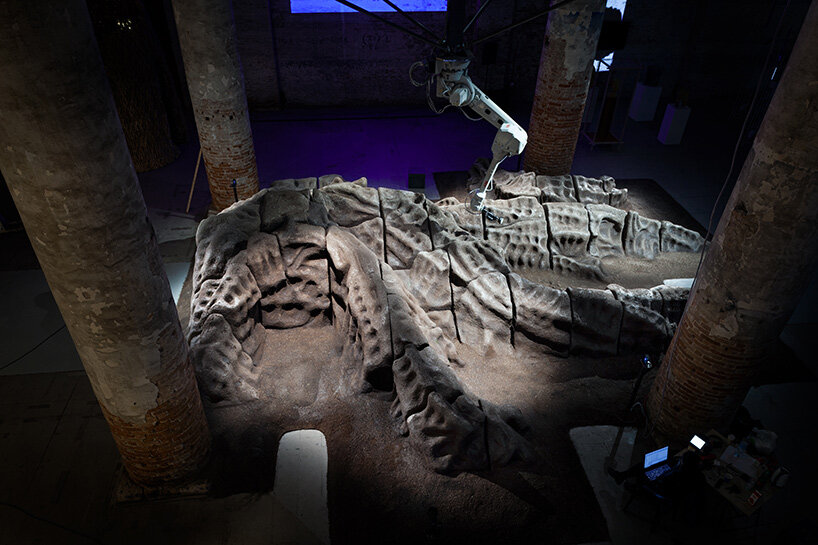
image © zita oberwalder
DM + TD (continued): we use a combined depth/RGB-camera and an additional tracking camera that runs a simultaneous localization and mapping (SLAM) algorithm and provides positional, orientational, and inertial data. the system runs entirely on a single-board computer (NVIDIA jetson nano). it sends data over a network to other machines that perform visualization and sonification of the image analysis results. we also use machine learning techniques to generate a complementary sound environment that is further processed based on the data from the computer vision system in a custom max/MSP environment. finally, bridging data gathering, machine vision, robotics with the natural environment will enhance new ways and opportunities for robots to be integrated into the natural and built environment.
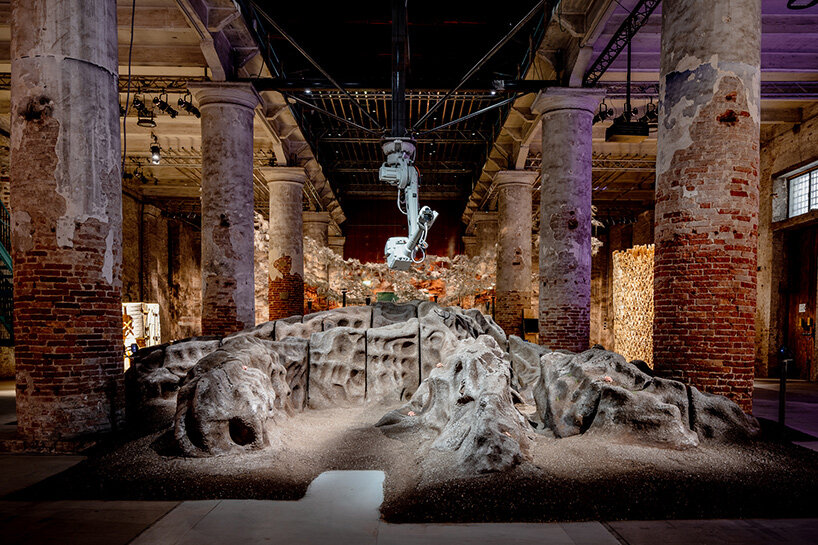
image © andrea avezzù
DB: how do you imagine the installation will look by the end of the biennale?
DM + TD: the idea behind magic queen is to have a structure that is able to evolve, decay, and grow during the timespan of the biennale. the structure was seeded with different types of grasses and inoculated with mushroom spores during and post-fabrication. operating in venice entails working with a very volatile environment in terms of humidity, temperature, and sudden climatic variations. this condition certainly will affect how the structure will change throughout the exhibition. the aim behind having an evolving structure is a very architectural one and has different exciting sides. on one side, we like to work with the idea that architecture doesn’t exhaust itself with one visit but instead uses infrastructure to stimulate our curiosity to return. on the other hand, working with a material system such as soil allows us to work with an entirely new set of physical parameters such as decay and aging. these parameters support the subject of temporary architecture. can we accept the idea that a building has its own metabolic patterns?
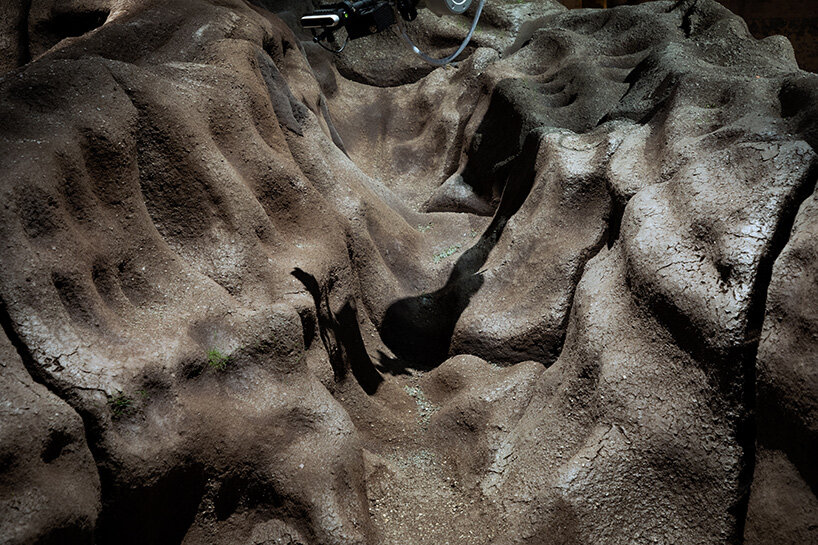
image © zita oberwalder
DB: how important was it that the entire structure is biodegradable?
DM + TD: the structure is fabricated using a novel robotic binder-jetting process for granular bio-composites and non-toxic binding agents. the combination of soil and hydrogel as building material shows the potential of a fully reversible construction process for architectural and landscape components and foresees its potential full-scale architectural implementations. architecture and building construction are currently placed within two polarities, the one defined by the environmental crisis and the other associated with a technological condition.
the building industry is now confronted with a significant responsibility towards sustainability, which requires a paradigm shift in building, manufacturing, selecting, and using materials. contemporary design practices have only a partial view of the life cycles and the process of construction and destruction of building materials. therefore, it is essential to confront the built environment with buildings constructed to last a precise amount of time. what happens after? biodegradability and decay are two fundamental components in the development of magic queen. those concepts highlight the problematic relationship between architecture, time (perhaps geological time), and decay. we were interested in working with those parameters during fabrication.
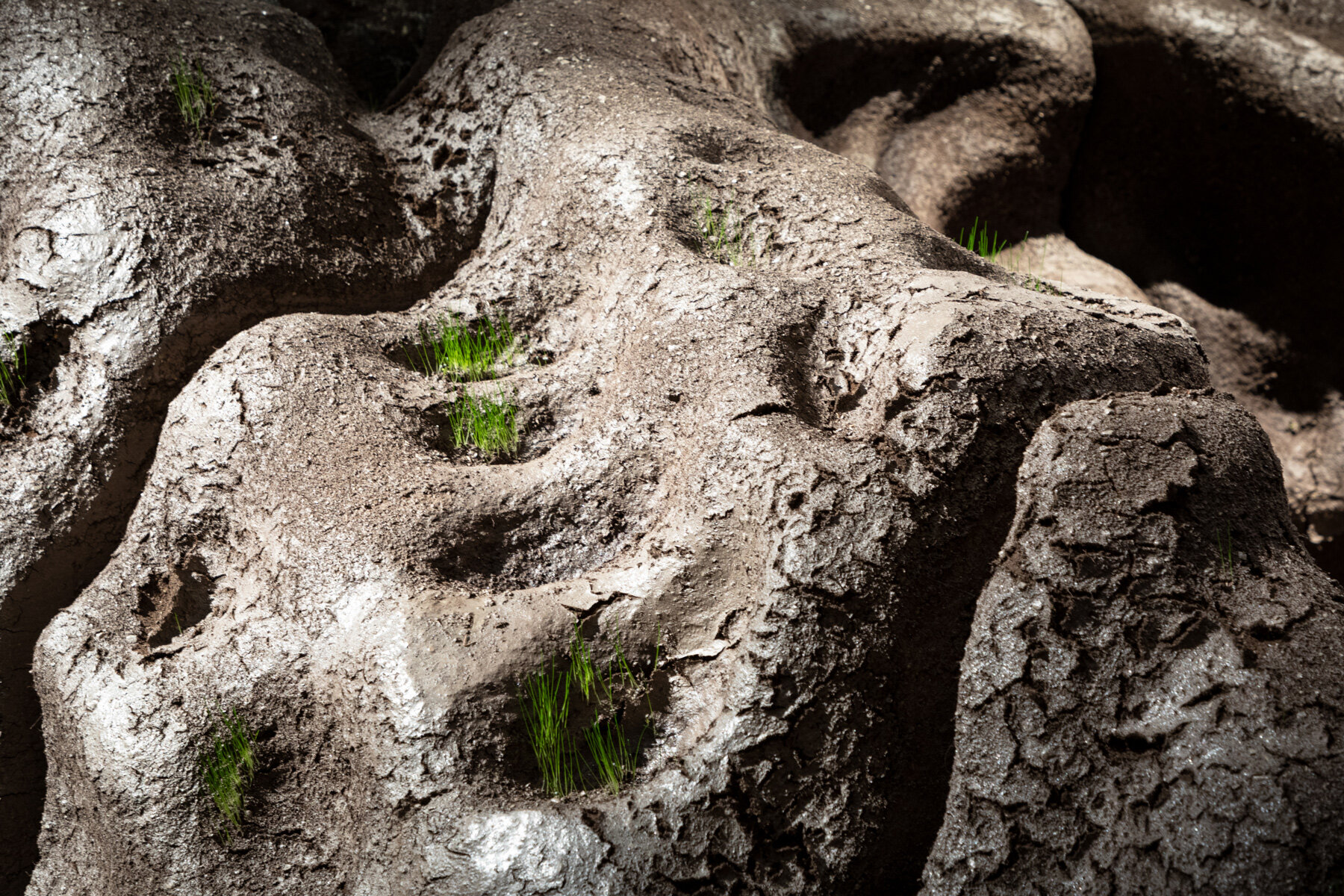
image © zita oberwalder
DB: what learnings from this project can be applied to future projects, and architecture in general?
DM + TD: architects, engineers, and designers spent a lot of time looking at nature as a source of symbolic inspiration. with the project, we create a new context in which the built environment and technologies are much more integrated into the natural system. if we take this challenge seriously, it will immediately restructure the built environment’s makeup and how products are form-found. the project has many direct implications for architecture and digital fabrication: the use of novel material systems that are fragile, the involvement of human interaction during the fabrication process, and the employment of biotechnologies into architectural design.
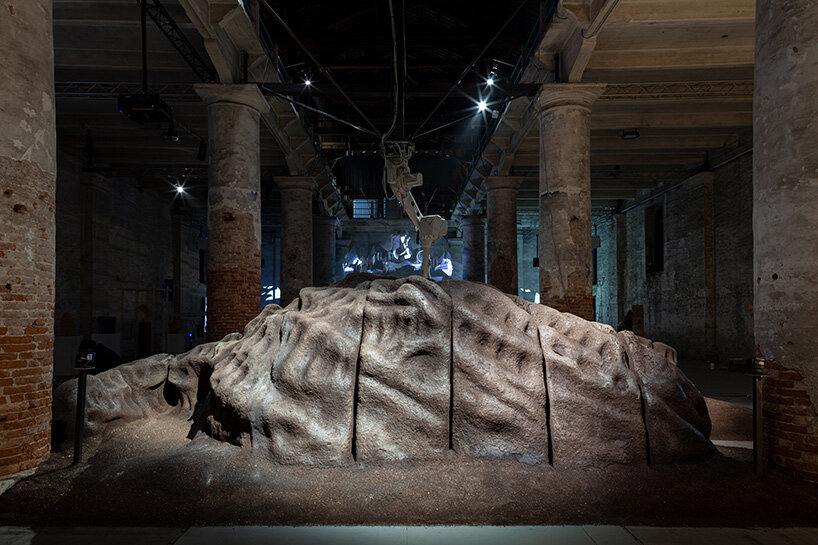
image © zita oberwalder
project info:
name: magic queen (soil, robotic arm, 1100 x 650 cm)
event: 2021 venice architecture biennale
location: venice, italy
design period: october 2020 – january 2021
fabrication period: march – may 2021 (three months)
size: 100 sqm of soil 3D printed structure
design: MAEID (büro für architektur und transmediale kunst) — daniela mitterberger, tiziano derme
project team: alex karaivanov, noor khadher, andrea cancian
structural system: johann riebenbauer
fabrication team: maria edurne morales zuniga, bahar al bahar, rodrigo perez hernandez, andreea bunica
student workshop (in alphabetical order): julian edelmann, federico gomarasca, raphaela elisabeth haller, ludwig-valerius rieger, thomas victor, philippe sicouri, zeno zoppi
in collaboration with:
visual interface: andrea reni
music and sound design: lukas lauermann, LOREM, luca pagan
AI and machine vision system: martin gasser
sponsored by: ABB, bundeskanzleramt wien / federal chancellery republic of austria, universität für angewandte kunst wien, stadt graz, land steiermark, leopold-franzens-universität innsbruck – institut für experimentelle architektur, department of microbiology
3D PRINTING (745)
ARCHITECTURE INTERVIEWS (263)
ARTIFICIAL INTELLIGENCE (351)
ROBOTS (529)
VENICE ARCHITECTURE BIENNALE 2021 (76)
PRODUCT LIBRARY
a diverse digital database that acts as a valuable guide in gaining insight and information about a product directly from the manufacturer, and serves as a rich reference point in developing a project or scheme.
